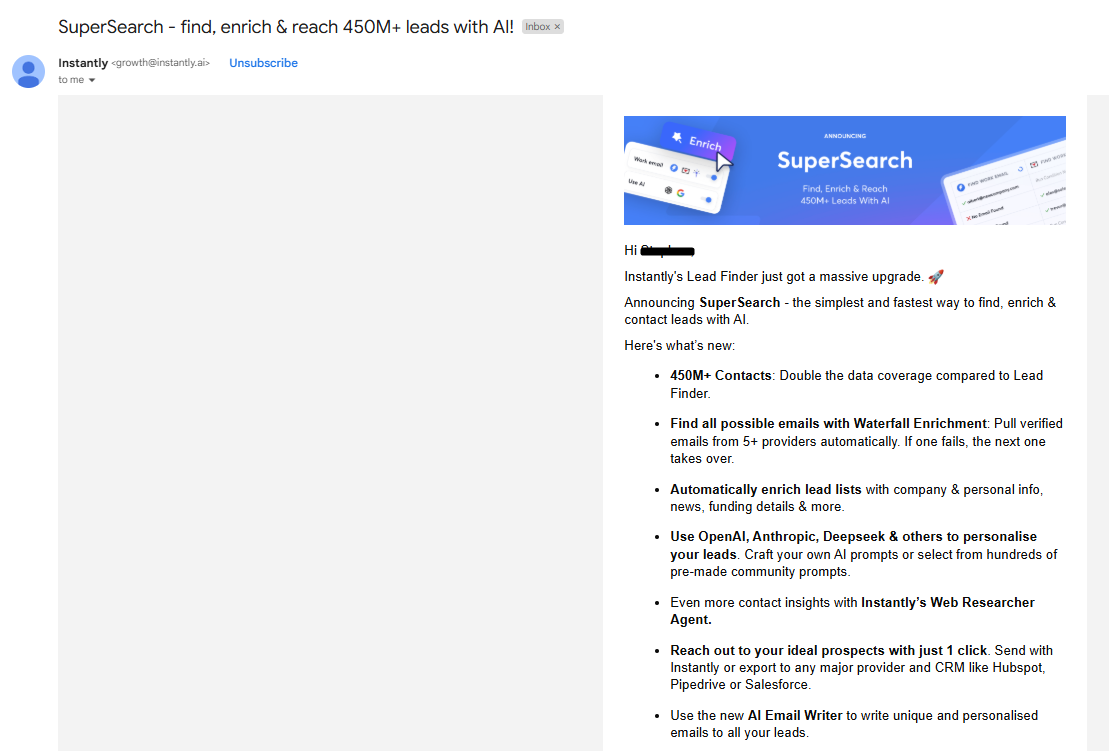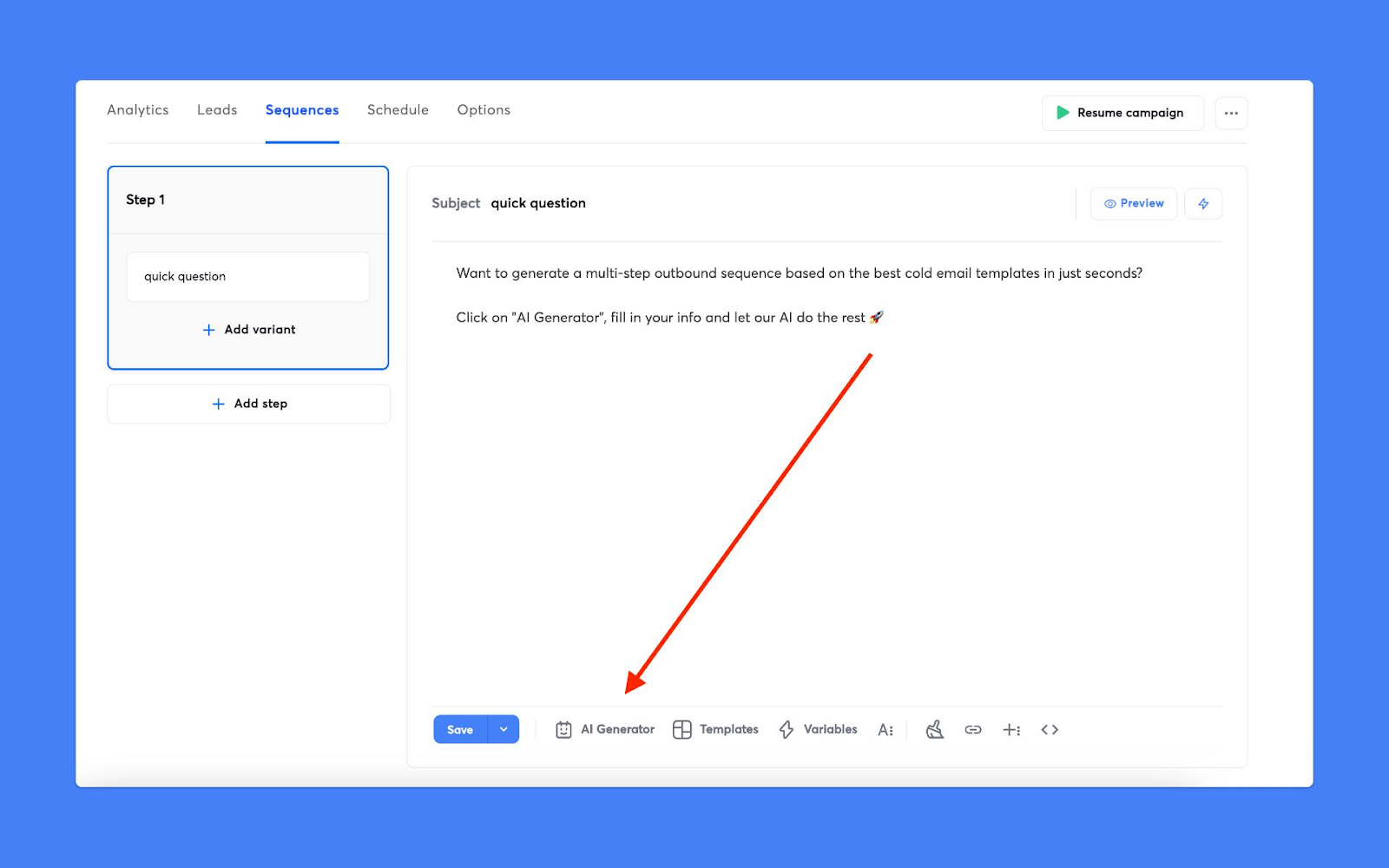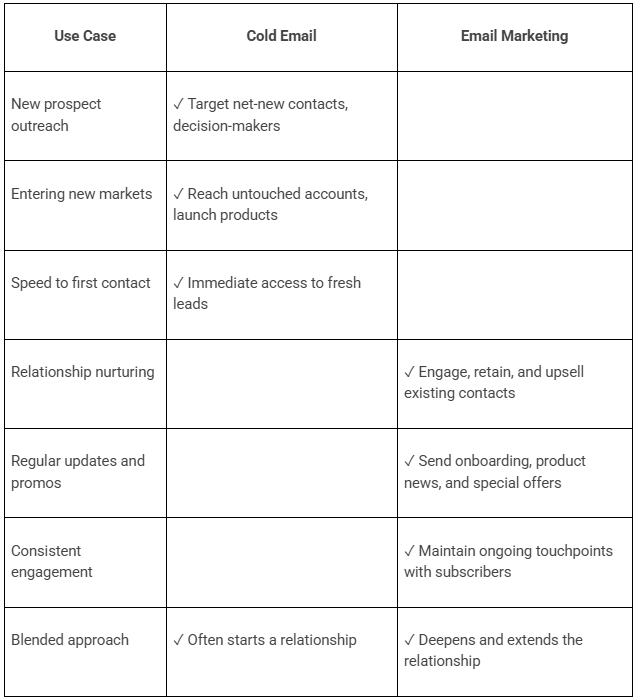Cold emailing and email marketing both involve getting emails into inboxes, but that’s pretty much where the similarity ends.
Cold emailing puts your message directly in front of someone who’s never heard of you. It’s personal, targeted, and high-stakes. Email marketing, however, plays a long game. It nurtures leads who’ve already shown interest, warming them up with content, offers, and trust-building tactics over time.
So which one’s right for you? It depends on what you’re trying to do. Do you need immediate conversations with decision-makers? Cold emailing works. Are you looking to build a loyal audience that buys later? Email marketing shines.
This guide breaks down when and how to deploy each for maximum impact. Because if you treat cold emailing like email marketing (or vice versa), you risk wasting effort and alienating potential customers.
What Is Cold Emailing? (And What Makes It Unique?)
Cold emailing is direct outreach to people who’ve never asked to hear from you. This isn’t spray-and-pray marketing. Each message lands in an inbox that’s often guarded, sometimes hostile, and always busy. The sender’s first job is to prove relevance in seconds.
For B2B sales teams, agencies, and recruiters, cold email acts as a wedge. It starts relationships that don’t exist and secures meetings with prospects who aren’t browsing your blog or signing up for your newsletter. The strongest campaigns use intent data, role-based targeting, and crisp copy that speaks to real business problems, not generic offers or recycled templates.
Benchmarks are unforgiving. Good campaigns might see reply rates of 1% to 5%. And depending on your industry, offering, and campaign effectiveness, it could reach the double digits. That slim margin means every detail counts: subject lines, timing, and the signal-to-noise ratio in the copy. Teams that treat cold email as a numbers game usually burn through domains and budgets without results.
Risks are real. Spam filters develop faster than most senders. One misplaced link or trigger phrase, and your domain reputation tanks. Compliance missteps open you to legal headaches. But for teams who build clean lists, personalize at scale, and track engagement closely, cold emailing opens doors that other channels just can’t reach.
What Is Email Marketing? (And Where Does It Shine?)
Email marketing speaks to people who want to hear from you. You’re reaching out to subscribers who raised their hands—your warm audience, not a list of strangers. That changes everything. Now, success depends on earning repeated attention and building trust with every message.
Marketing teams, SaaS brands, and e-commerce companies put email marketing to work every day. It turns signups into users, nudges free users to upgrade, and keeps loyal customers coming back.
A message might introduce a new feature, deliver a curated offer, or just share something worth reading on a busy morning. Here’s an example from one of our most recent campaigns at Instantly.ai:

Automation does the heavy lifting. Campaigns fire off automatically, triggered by behavior or set to a schedule. The strongest marketers slice their lists, adjusting content and timing so each email feels personalized, even if it’s going out to thousands at once.
This pays off in real numbers. People who already trust your brand are far more likely to open, click, and buy again. Retention rates rise. Upsell offers land in the inboxes of users who are ready to buy more. With the right strategy, each send strengthens the bond between your company and your customers.
Comparing the Two: Tactics, Outcomes, and ROI
Cold emailing and email marketing might both drop a note in the inbox, but how you get there (and what happens next) couldn’t feel more different. Let’s break down how each approach shapes your results, starting from the very first list you build.
Targeting and List Building
Cold emailing means building your list from zero. The people you’re reaching have never heard from you before. You’re hunting for just the right titles at just the right companies, watching for signals that someone might care about what you say.
One bad address or generic list can send good emails straight to spam. When you get targeting right, you spark real conversations. But miss the mark, and you’ll see nothing but bounces and unopened mail.
Instantly’s Lead Finder gives you access to millions of up-to-date B2B contacts with filters for company, job title, and industry, so you can build hyper-targeted, high-quality lists right from the start.
Email marketing starts with a warmer welcome. Here, people sign up because they want what you’re offering—product updates, special deals, or an inside look at your world. The work shifts to keeping these subscribers engaged and making sure they don’t tune out. Success comes from smart list-building (think: forms, gated resources, and product trials) and thoughtful segmentation, so every message lands with the right crowd.
Instantly lets you segment, manage, and trigger campaigns to the most relevant audiences, keeping your nurture flows and promotions on point as your lists grow.
Message Craft: What Gets Opens and Replies?
Cold emails demand brevity. You’re showing up as an unknown name, so you get maybe a few seconds to prove you belong. The best campaigns use sharp subject lines and first sentences that speak directly to a prospect’s responsibility or pain point. Every word has a job. Personalization goes beyond adding a name. You reference their work, market, or a shared problem.
Instantly’s AI Sequence Generator tailors cold emails to industry, pain points, and role, helping you scale true personalization campaign by campaign.

Email marketing allows for more storytelling and creativity. You can use eye-catching design, in-depth content, and longer narratives. With more attention from the subscriber, you can educate, promote, and engage with a wider range of tactics. Offers, product updates, and thought leadership pieces all have room to breathe, as long as each message matches the recipient’s expectations.
Deliverability: Getting in the Inbox
Cold emailers battle inbox obstacles from the start. Every new domain, sending IP, and message is closely watched by spam filters. List hygiene, sending volume, and authentication are constant priorities. Warm-up routines and careful monitoring are part of the process if you want messages to land instead of bounce.
Email marketing benefits from established trust. Engagement drives deliverability, so lists that regularly open and click continue to receive mail. Bad habits, like list neglect or sending irrelevant content, can still tank results, but the “warm” nature of the audience gives more leeway. Protecting sender reputation is less precarious, but still essential.
Instantly’s automated warmup tools and real-time deliverability analytics work in the background to keep your sending reputation healthy and your emails in the inbox.

If interest dips or engagement falls, Instantly flags it fast so you can adjust and keep results strong. Try Instantly today at zero cost!
Compliance: Staying on the Right Side of the Law
Regulations draw a sharp line between these approaches. Cold emailing is subject to strict rules about consent, opt-out mechanisms, and data privacy. Mishandling personal information or skipping unsubscribe links can result in legal penalties and blacklisting.
Instantly manages unsubscribe links and automates opt-outs for every cold campaign, making compliance a box you never forget to check.
Email marketing must also meet standards for disclosure and opt-outs, but consent is built in from the start. You have a clearer legal path, as long as you respect subscriber preferences and manage data responsibly.
In both approaches, success relies on respecting boundaries, monitoring performance, and adapting your tactics before problems become penalties. With Instantly powering your outreach, you scale confidently (without sacrificing compliance, deliverability, or quality control).
When Should You Use Cold Email? When Should You Use Email Marketing?
Start with three questions: Who’s your audience? What outcome do you need? How fast do you need results?

Key Takeaways
Cold emailing opens doors to new prospects, while email marketing builds lasting relationships with existing contacts.
List quality, message craft, deliverability, and compliance all shape your results—there’s no one-size-fits-all answer. The best teams choose the right tool for every stage, then use data to optimize what’s working.
Ready to put power behind your strategy? Sign up for Instantly and see how easy it is to scale winning campaigns from first touch to loyal customer.




